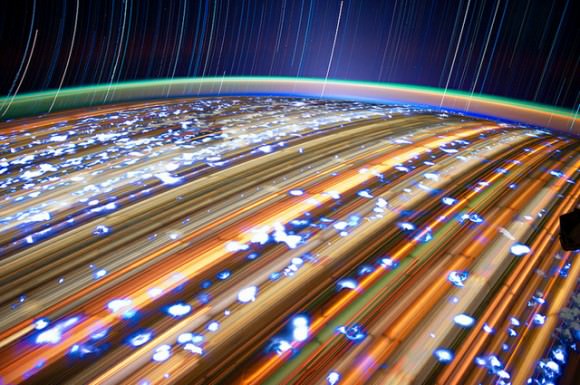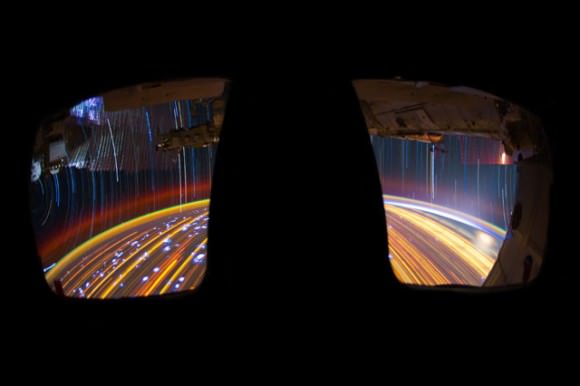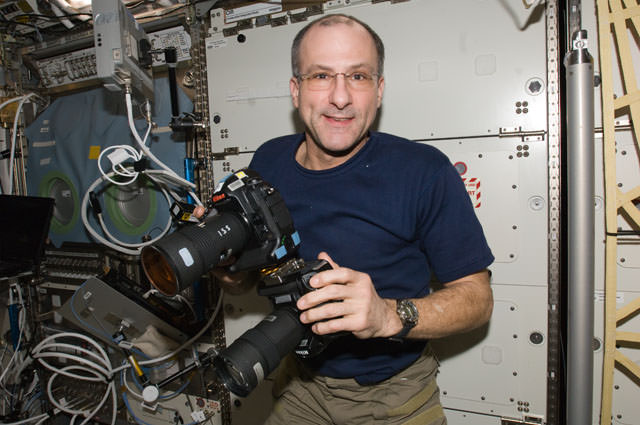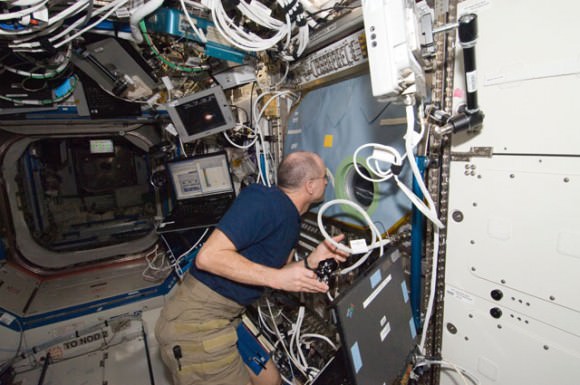After completing 193 days in space as a member of the Expedition 30 and 31 crews, astronaut Don Pettit returned to Earth on July 1, 2012. Don is not your average, ordinary, fighter-pilot astronaut: he’s got a penchant for science, with a unique way of looking at things. He spent his expedition performing crazy zero-gravity experiments, grappling the first commercial spacecraft to visit the ISS, and blogging as his alter-ego, a zuchinni plant, among other things. Universe Today had the chance to talk with Pettit this morning about his experiences:
Nancy: Good morning Don. It’s an honor to talk with you. Congratulations on such a successful expedition.
Don Pettit: It’s great to talk with you!
Nancy: You did a lot of science experiments during your stay in space, both the official ISS program experiments and also your own “Science off the Sphere” experiments. Of the official ones, which was the most interesting and engaging or perhaps what you felt was the most important experiment that you did?
Don Pettit: There were two categories of experiments that really captivated me. One is the human life science experiments that we do on ourselves, where we poke and prod ourselves and take blood and other samples, trying to figure out how this thing called the human being operates in a weightless environment. The other category of experiment that I thought was really fascinating was combustion. That’s a fancy way of saying ‘fire’ which of course is what is required to power our current civilization.
Caption: Pettit working with the Structure and Liftoff In Combustion Experiment (SLICE) in the Destiny laboratory of the International Space Station. Pettit conducted three sets of flame tests, followed by a fan calibration. This test will lead to increased efficiency and reduced pollutant emission for practical combustion devices. Credit: NASA
Nancy: What was your favorite Science off the Sphere experiment that you did?
Don Pettit: Oh, probably the one that has to do with the knitting needles and looking at charged droplets in a stable orbit around the knitting needles. That was really fun and simple and a fun demonstration of what you can do when you remove gravitational forces and replace them with small forces like charged forces.
Nancy: I think that was my favorite one too!
I want to say thank you on behalf of everyone, I think, on planet Earth, for the amazing images you took during your mission– the star trails, the aurorae, the transit of Venus are just a few examples — your images were just spectacular. How important is the photography that the astronauts do as far as documenting your expedition and being able to share your experiences with the public?
Don Pettit: If a picture is worth a thousand words and we take thousands of pictures that certainly says something in terms of the magnitude of communication we can have in conveying this amazing environment to people on Earth, who are of course, the ones collectively who makes this happen, and we are the lucky ones that get to go into space.
Part of any explorations, when you are going into the frontier and you come back you need to explain to people what the frontier is like, you need to share the stories and experience. Images now are one of the prime ways of doing that. I think the taking of both still images and video in space is not only an important pastime for the astronauts to do, but important to convey to the public that ultimately funds the space program, what is going on up there and how wonderful an environment this is. And eventually our technology will move to the point where people, wholesale, can jump in their rockets and go into this frontier.

Caption: Petit left his camera shutter open for long periods of time to capture star trails and trails of lights on Earth.
Nancy: We sure hope so!
You were an integral part of the SpaceX Dragon grapple and berth, the first commercial spaceship to visit the ISS. After being a part of that, what are your thoughts about the private industry becoming perhaps a vital part of human spaceflight, and in particular for space station operations?
Don Pettit: The commercial space is a natural flow for going into a frontier environment like space. You can see analogs of the wild west in the United States getting settled with a combination of both government programs and government sponsored commercial programs and I think we are going to see the same thing going into space. It’s an important aspect of opening the frontier so that more than just a few government-born programs can operate in this environment.
Nancy: Thanks Don, great to talk with you!
Don Pettit: It’s a pleasure.
I also wanted to ask him a few other questions, but ran out of time. At a reader’s suggestion I was going to ask him about the eggs on the Angry Birds Space video, and how he got them into space. Robert Pearlman from collectSPACE later asked him that question, however, and Pettit replied coyly that all astronauts has some personal items they can bring up, but as to how they got up there, Pettit said he’d leave that one unanswered.
I loved Pettit’s analogy about being an explorer of the frontier and in later interviews he had a great comment about Tweeting and exploring:
Don Pettit: Part of any exploration, like when the Antarctic was explored, they’d return home and tell their stories, spread their experience with those who didn’t have the good fortune get to go, and we are using what is available to us now. If Shackleton had the ability to Tweet, I’m sure he would have Tweeted during his expeditions to Antarctica. On station we have limited time and bandwidth and have help from people on the ground who will help get our information out.
I do get feedback (from his social media posts) and some of the comments will get condensed and sent up to me in an email message, and I take the time to read those. Some bring a pretty big smile to my face. And it is neat to see that you are having an effect, that people are following what you are doing and listening to some of the stories you have to tell.
Pettit talked more about his opportunity for photographing unique astronomical events in space:
Don Pettit: One of the most amazing things is to be able to see something like a comet. We saw a comet, saw a solar eclipse and the transit of Venus, so had a number of fairly rare natural astronomical phenomena. When you see it from space, the vantage point is slightly different and allows you to see the physics of the situation– the shadow of the Moon appears as a dark spot on Earth, and lets you know that, gosh, the guys who wrote the textbooks about this figured all this out without seeing it from this vantage point.
Pettit added that the Transit of Venus was an amazing opportunity, and he brought a full-aperture solar telescope just for the occasion. He said he hopes the images they were able to collect hopefully will be useful in the whole ensemble of images that people took from Earth of the event.
Pettit has now spent a total of 370 days in space, more than a year of his life, and he was asked if he would like to go back:
Don Pettit: I would love to fly back to station again, but there is a bunch of folks standing in line, and everyone needs to wait their turn — there is certain fairness on how this happens. I will throw my name in the hat and get back in line and see what happens. The assignments now go out to about 2015, so if space station has a lifetime to about 2020, about half of all the people going to station have already been assigned.
Later Pettit said: I would go back to space in a nano-second. That’s what I do for a living and give me a few days to get my feet on the ground and I’m ready to go again.
And then he was asked if he would go on a mission away from Earth:
Don Pettit: I’d be willing to immigrate into space and not come back as long as we would have the technology to survive. Going one way to Mars and then running out of air to die is not in the cards. If you went to Mars like people went from continental Europe to the New World, I’d load my family up in the next rocket and we’d immigrate into space.

Caption: Another star-trail image by Pettit.
Another question was if being in space ever gets routine.
Don Pettit: It can be both special and routine. Take your breakfast for example. I found that humans like to have a routine for breakfast, and that gives you certain amount of comfort. But it doesn’t get routine as far as living and working in space. Every day has another eye-opening piece of excitement and you learn something new and that is part of being on a frontier.
About his blogging from the perspective of a zucchini plant in space:
Don Pettit: I wanted to write from the equivalent of a potted plant in the corner, and I wanted to write about it because the technology associated with it is not necessarily straightforward, and I could make it like a gardening manual in space. I decided to write the story of how you grow plants in space from the eyes of a zucchini.
Pettit was asked which transition is harder: going to space or coming back to Earth:
Don Pettit: The adjustment going to space is easier than coming back down to Earth. It takes a while to get rid of this heavy feeling.
Later he said that his first thoughts on landing were, “Welcome back to gravity this is really tough,” and then “when do I get to hug my boys?”
What does the ISS smell like?
Don Pettit: Part machine shop, engine room, laboratory and then when you are cooking dinner and rip open a pouch of stew you can smell a little roast beef.



Thanks for sharing Don Petit’s great insights and experiences. He’s a modern day hero and quite the renaissance man as he has shown in his photos.
I really liked the long exposure photos of Earth. Not ground breaking science, but very pretty.
Hi Nancy, this is (as always) a great article from you and I admire Don’s work. I have, however, one comment: Why is it that the (fantastic) work of Don gets so much more attention at Universe Today than the work of Andre Kuipers? Looking at the followers of Andre at Facebook and Twitter and his published images and research work, I think Andre is not getting the attention by Universe Today that he deserves.